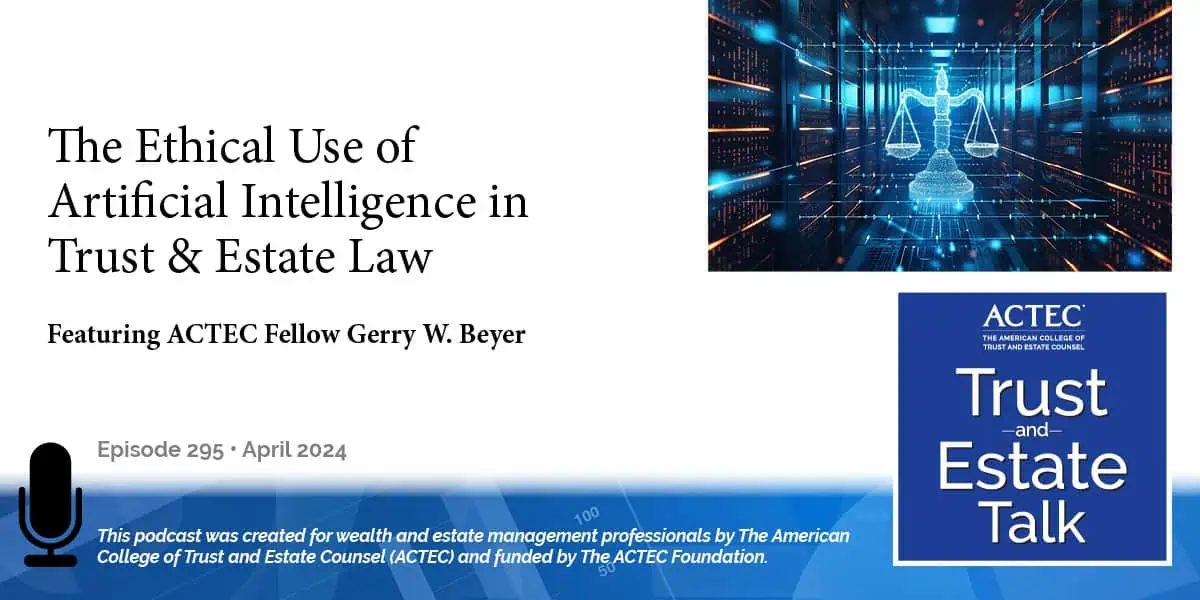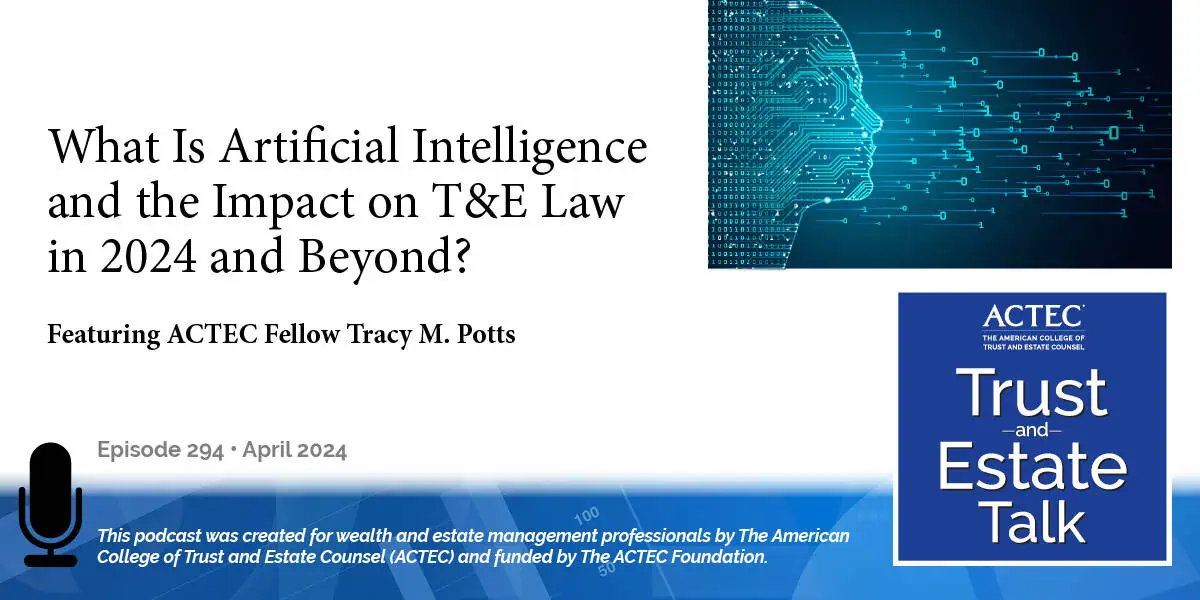Lending and Estate Planning

“Lending and Estate Planning,” that’s the subject of today’s ACTEC Trust and Estate Talk.
Transcript/Show Notes
This is Lois Ann Stanton, ACTEC Fellow from Austin, Texas. What every estate planner, trust and business advisor should understand about using lending techniques in their estate planning. To give us more information on this topic, you will be hearing today from ACTEC Fellows Rebecca Wallenfelsz from Chicago, Illinois, and Peter Conaty from Wilmington, Delaware. Welcome Rebecca and Peter.
Most of us are familiar with the use of debt, either because we have got a client who has a business, or there is a trust, or there is an event that requires someone to raise some capital, or they need some liquidity, or that there is a technique that is available in estate planning where maybe borrowing makes more economic sense than selling an asset or creating the liquidity event yourself. But there are some unique credit issues that come up, aside from the tax issues that come up, that are really important to understand. So, Peter why don’t you mention some of those techniques for us?
Graegin Loan
One of the first techniques is the Graegin loan. A Graegin loan is a loan to the estate – typically in an estate of significant size from a related or unrelated third party – in order to facilitate the payment of estate taxes and other expenses of the administration of the estate, the interest of which is deductible under Section 2053(a)(2) of the Code. In summary, in structuring a Graegin loan, the transaction documents should reflect the following: first, that you should have an estate that is illiquid; the loan should be a bona fide loan. The loan should prohibit the prepayment as well as accelerate any interest that may be due on the note in the event of a default. There should be a non-tax purpose, and the amounts deducted should be allowable under the laws of the state in which the estate is being administered.
So and with that, one of the things that the IRS looks at in that is how commercially reasonable is that loan transaction? And, it is easy if you are going to a third-party lender to say this is commercially reasonable because the third-party lender is going to have their criteria for what is needed in order for them to make that kind of loan. And with that, any third-party lender, right, they are really going to look at the creditworthiness of the estate. And that is really going to start to be difficult because one, the estate is just a new entity. It doesn’t have a credit history, which is one of the things you look at when you are looking at creditworthiness. Second is it is going to be looking at cash flow. Sometimes the estate may have some cash flow depending on the nature of the assets it has, but oftentimes the type of estate who is going to do this transaction is going to be one that has illiquid assets, and illiquid assets that they don’t want to sell in the first place. And that may or may not come with some cash flow. So that is going to be hard for a lender. Who wants to loan to an entity that can’t pay you back and doesn’t have cash? Right?
So, they are going to be looking at that and they are also going to be looking at, where is the source of repayment going to come from? What kind of collateral can they get? And because this is a new borrower, it is a new entity. You know, they are going to be looking at all of these things. And a lot of times, they are going to be looking at, well, maybe getting those cash flow sources and the collateral that may be liquid from other related entities – from another trust, from another family member. What is relevant to understand in that too is when you are doing this kind of structure, then for the estate, even if you are going to a related entity, you want to look at all of those things. You want to have the same kind of assessment of this estate. How creditworthy is it? What is the repayment method? Where is that cash flow going to come from? What kind of collateral are you going to get, and particularly where that lender is going to be, maybe, the trustee of a trust like an ILIT that has some liquidity. You know, they are a fiduciary. And so, they are going to have to do an assessment of making this loan and this being prudent from that perspective. So, having a well-prepared ILIT in that example or being prepared to go to that third party lender and having all your ducks in a row and understanding exactly what the lender is going to require is going to make that transaction a lot easier. So, Peter, what other technique is there besides Graegin loans?
Grantor Retained Annuity Trust (GRAT) and Intentionally Defective Grantor Trust (IDGT)
Another technique is using leverage in grantor retained annuity trusts and also in intentionally defective grantor trusts. So as an example, using leverage to maintain appreciation in the GRAT. And in summary, oftentimes it may make sense after you have a GRAT that – let’s say you are in the first or second year and the asset has appreciated significantly, and the client is concerned that there may be depreciation in the following year, it may make sense to go out (obviously, if you have other assets that you can utilize, that may be fine. But in the event that you don’t have any other assets, to go out) and borrow funds and then to substitute the funds from the loan into the GRAT and then take out that appreciating asset – by doing that, if the asset then depreciates, it doesn’t matter. The GRAT is still on course to be very successful.
The technique can also be used in a failing GRAT where the GRAT may have, in the first or second year, depreciated substantially. This would allow, by going through the loan process and substituting the assets – once again, the assets would be taken out of the GRAT that have depreciated substantially – it would allow the grantor the ability to create a new GRAT and start the process over sooner rather than later, having to wait until the end of the term of the original GRAT. Of course, in that case, there is a substantial likelihood that the new GRAT will be successful because you are starting out with the depreciated asset and you still believe that it may appreciate. And of course, the original GRAT will most likely fail, but there is really not a whole lot of consequence to that.
Also, leverage is used in intentionally defective grantor trusts. We primarily see that in installment sales. And then also, not only installment sales, but also where you may have assets that are in an intentionally defective grantor trust that have appreciated substantially over the years, have a low basis. The grantor may be getting old or may be in declining health and it very well may make sense to substitute the assets, bring the low basis assets back into the grantor’s estate – the grantor having obtained the loan and substituted those assets. Then when the grantor dies, there would be a stepped-up basis for those assets, and depending on the value of those assets, it could be a substantial tax savings for the family.
And the other time lending techniques are used for GRATs and for intentionally defective grantor trusts are: the trust itself is going to borrow the money and borrow the money to finance the payment of annuities, to borrow to finance the payment of the installment note or to repay the grantor on that installment and note for the asset it originally purchased. And when the borrower is the grantor directly and they are using it to do the substitution to pay that, then it’s just based on the creditworthiness of that grantor and their capacity for repayment. But when it’s that trust, when it’s that GRAT and when it’s that IDGT- we will call it – who is the borrower, that then presents some unique challenges for a lender. And often it’s a third-party lender, but again, it can still be a related-party lender. There might be another family trust, another family business out there that has maybe a liquidity that it’s going to provide. And whether it’s a business or a trust, those are – it can be fiduciaries who owe obligations to the beneficiaries, to their shareholders or members when they do those transactions. And so, there the challenge is often the same as what I talked about for a Graegin note. You are giving the loan to an entity that has usually an illiquid asset that may or may not have some good cash flow in order to repay that debt obligation and may have, especially if you are talking an intentionally defective grantor trust, has maybe, then, a really high debt to asset ratio. So from a credit risk perspective, that’s a poor investment; and it is a poor loan to make unless you can sometimes layer and ask for a guarantor. You have another family member or an entity that acts as a guarantor or that has liquid assets to pledge as collateral.
And there, you have got to be really careful because bankers like to point out the other possibilities of the family members, including the grantor themselves, who maybe could pledge or be a guarantor from that debt. And that starts going down a dangerous road, where you are bringing the guarantor back into that fact pattern, especially where it’s a loan to repay the grantor for money that’s owed from the trust. But with that, you know, there are a couple of things that can be done. You can have the trust pay the grantor a premium for that guarantee fee so that it’s a fair exchange for that. There may be other assets that are then available. But again, you want that debt obligation, that debt, that loan to that trust to look like a true debt, especially when it is from a related party. So that also means looking at the interest rate that is being charged, making sure that is at commercially reasonable rates given the nature of who your borrower is and what their creditworthiness is. So, I think we have time for one more technique, Peter.
Life Insurance Premium Financing
Alright. The last technique is life insurance premium financing. Premium financing is the borrowing of funds in order to procure a life insurance policy and satisfy the premiums associated with such a life insurance policy over the lifetime of the policies. Essentially, you see this technique when there is a need for liquidity at death, the person has significant wealth but is not in the position to utilize such assets at the time of the creation of this program, and is generally of an advanced age.
The structure, real quickly, is through an irrevocable life insurance trust (ILIT); then there is a financial institution which will lend money to the trust in exchange for the payment of interest. The interest is either paid by gifts by the grantor by making annual exclusion gifts to the trust and in exchange for the payment of interest, which is usually typically set at one year LIBOR rate or some other indice. The loan is typically secured by the policies as well as a personal guarantee and/or other marketable securities. The trust uses the funds to pay the premiums; and really, in a summary, that’s premium financing.
Yes – and from a third-party lender, especially who often gets involved in premium financing. Right? For them, the first asset, right, is going to be the insurance policy, but it’s going to be based on the cash value of that insurance policy. The cash value usually can be fairly small unless the policy has been around for quite a while, which generally then means that you have got to find some other assets. They are going to require that you go out and have some other family member, some other family entity that is going to provide collateral or provide a guarantee for that premium financing. So it’s going to put those assets – make them liable for the payment on this. And a lot of times most financial institutions, they require liquid assets, not illiquid assets. And that can be a challenge, especially if – a classic situation where you are creating the ILIT, you are getting the insurance to pay the estate taxes because there is a lack of liquidity to pay it in the first place. And so that’s why you have got the premium there.
So, there may not be that many other assets that are available, in which case you have to go out and find a lender who is willing to take the pledge against that illiquid asset. But if you do have liquid assets, right, that’s what the lender is going to require. So that does almost always mean you are looking at the settlor or the insured who is giving it a personal guarantee, perhaps of that loan, other family members, maybe some other family assets that have, or trusts that have liquidity to pledge. The question always is, especially when it is another trust, does that trust, in fact, and that trustee have the ability to guarantee that debt obligation for another trust? That is not something that is typically written into trust documents; and so this is where I encourage planners always to look at your documents, see what the powers of a trustee are. Borrowing and pledging by themselves may not be enough, but do they have the ability to guarantee, to pledge their own assets for debt obligations of their beneficiaries of related parties?
Maybe expanding that language so that it exists in there, and that protects a fiduciary when they are asked to do that and they think it makes some sense to do that. Or again, you just have the ILIT – maybe pay a guarantee premium fee to that other family trust that’s providing the guarantee for that. So that allows that trustee to engage in that transaction. But again, this area is fraught with some holes. You have got to think through and be careful in your drafting, be thoughtful in that. If you are prepared and you know that there is going to be the lending transaction ahead of time, it’s easier to prep the documents, it’s easier to prep the client, and easier to deal then with the financial institution if you are getting that loan from a financial institution.
Thank you, Rebecca and Peter, for educating us on how to use various lending techniques in our estate planning.
This podcast was produced by The American College of Trust and Estate Counsel, ACTEC. Listeners, including professionals, should under no circumstances rely upon this information as a substitute for their own research or for obtaining specific legal or tax advice from their own counsel. The material in this podcast is for information purposes only and is not intended to and should not be treated as legal advice or tax advice. The views expressed are those of speakers as of the date noted and not necessarily those of ACTEC or any speaker’s employer or firm. The information, opinions, and recommendations presented in this Podcast are for general information only and any reliance on the information provided in this Podcast is done at your own risk. The entire contents and design of this Podcast, are the property of ACTEC, or used by ACTEC with permission, and are protected under U.S. and international copyright and trademark laws. Except as otherwise provided herein, users of this Podcast may save and use information contained in the Podcast only for personal or other non-commercial, educational purposes. No other use, including, without limitation, reproduction, retransmission or editing, of this Podcast may be made without the prior written permission of The American College of Trust and Estate Counsel.
If you have ideas for a future ACTEC Trust & Estate Talk topic, please contact us at ACTECpodcast@ACTEC.org.
© 2018 – 2024 The American College of Trust and Estate Counsel. All rights reserved.
Latest ACTEC Trust and Estate Talk Podcasts

The Ethical Use of Artificial Intelligence in Trust & Estate Law
A law professor offers insights into the risks, rewards, duties and ethical considerations of lawyers using AI in their T&E practices.

What Is Artificial Intelligence and the Impact on T&E Law in 2024 and Beyond?
A primer on the types and uses of AI, then a deeper dive into the impact on trust and estate law from types to applications to ethical considerations.

The IRS Ruling on Modifying a Grantor Trust
Explore the gift tax implications for trust beneficiaries modifying grantor trusts in IRS CCA 202352018, with nuanced analysis and estate planning insights.

